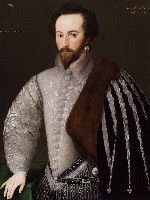Walter Raleigh
Biography of Walter Raleigh

Sir Walter Ralegh (/ˈrɔːli, ˈræli, ˈrɑːli/; c. 1552 – 29 October 1618), also spelled Raleigh, was an English statesman, soldier, writer and explorer. One of the most notable figures of the Elizabethan era, he played a leading part in English colonisation of North America, suppressed rebellion in Ireland, helped defend England during the Spanish Armada and held political positions under Elizabeth I.
Raleigh was born to a Protestant family in Devon, the son of Walter Raleigh and Catherine Champernowne, and a cousin of Sir Richard Grenville and younger half-brother of Sir Humphrey Gilbert. Little is known of his early life, though in his late teens he spent some time in France taking part in the religious civil wars. In his 20s he took part in the suppression of rebellion in the colonisation of Ireland; he also participated in the siege of Smerwick. Later, he became a landlord of property in Ireland and mayor of Youghal in East Munster, where his house still stands in Myrtle Grove. He rose rapidly in the favour of Queen Elizabeth I and was knighted in 1585. He was granted a royal patent to explore Virginia, paving the way for future English settlements. In 1591, he secretly married Elizabeth Throckmorton, one of the Queen's ladies-in-waiting, without the Queen's permission, for which he and his wife were sent to the Tower of London. After his release, they retired to his estate at Sherborne, Dorset.
In 1594, Raleigh heard of a "City of Gold" in South America and sailed to find it, publishing an exaggerated account of his experiences in a book that contributed to the legend of "El Dorado". After Queen Elizabeth died in 1603, Raleigh was again imprisoned in the Tower, this time for being involved in the Main Plot against King James I, who was not favourably disposed towards him. In 1616, he was released to lead a second expedition in search of El Dorado. During the expedition, men led by his top commander ransacked a Spanish outpost, in violation of both the terms of his pardon and the 1604 peace treaty with Spain. Raleigh returned to England and, to appease the Spanish, he was arrested and executed in 1618.
Poetry
Raleigh's poetry is written in the relatively straightforward, unornamented mode known as the plain style. C. S. Lewis considered Raleigh one of the era's "silver poets", a group of writers who resisted the Italian Renaissance influence of dense classical reference and elaborate poetic devices. His writing contains strong personal treatments of themes such as love, loss, beauty, and time. Most of his poems are short lyrics that were inspired by actual events.
In poems such as "What is Our Life" and "The Lie", Raleigh expresses a contemptus mundi (contempt of the world) attitude more characteristic of the Middle Ages than of the dawning era of humanistic optimism. But his lesser-known long poem "The Ocean's Love to Cynthia" combines this vein with the more elaborate conceits associated with his contemporaries Edmund Spenser and John Donne, expressing a melancholy sense of history. The poem was written during his imprisonment in the Tower of London.
Raleigh wrote a poetic response to Christopher Marlowe's "The Passionate Shepherd to His Love" of 1592, entitled "The Nymph's Reply to the Shepherd". Both were written in the style of traditional pastoral poetry and follow the structure of six four-line stanzas employing a rhyme scheme of AABB, with Raleigh's an almost line-for-line refutation of Marlowe's sentiments. Years later, the 20th-century poet William Carlos Williams would join the poetic "argument" with his "Raleigh Was Right".